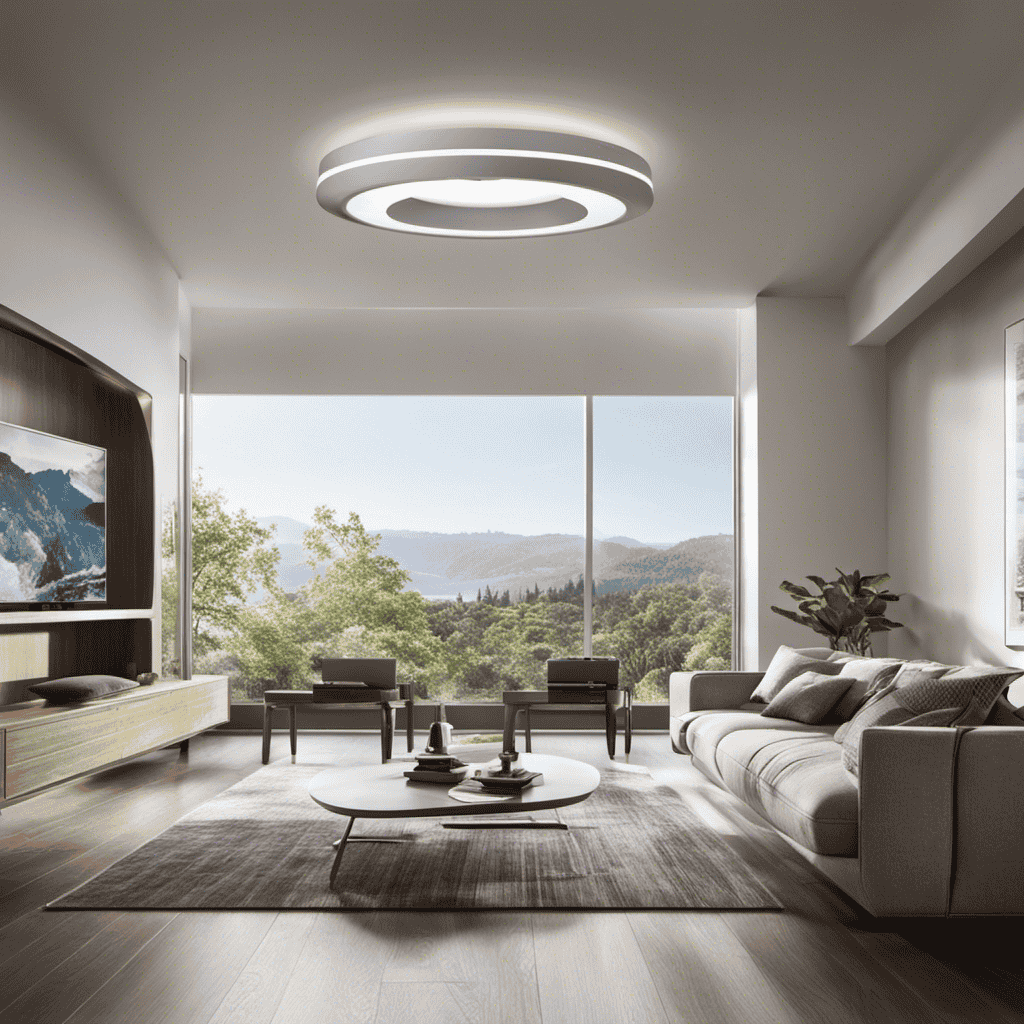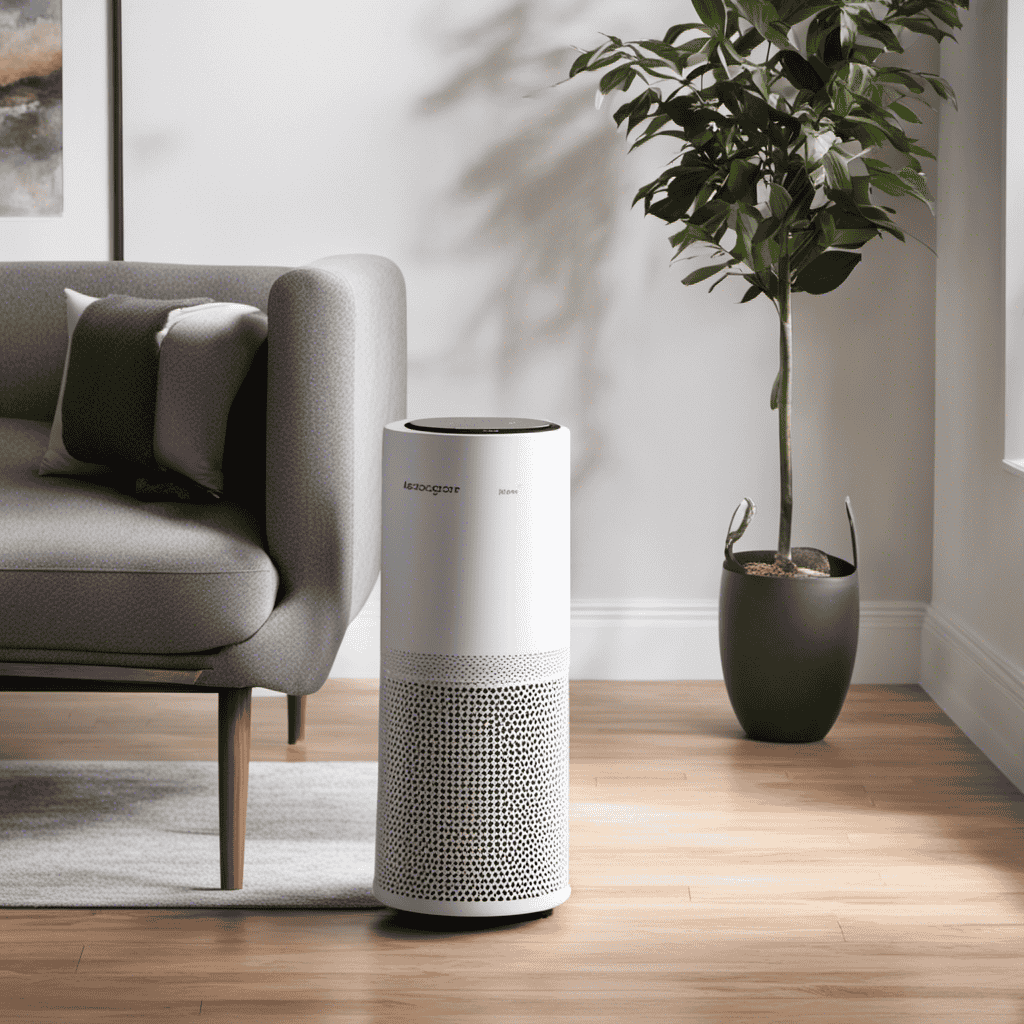When it comes to selecting the right air purifier, size is an important factor to consider. How can you figure out the ideal fit for your space?
In this article, I’ll guide you through the important factors to consider when selecting the ideal air purifier size. From evaluating the room dimensions to matching the purifier’s CADR, we’ll explore all the essential elements to ensure you make an informed decision.
So let’s dive in and find the air purifier that’s just right for you.
Key Takeaways
- Air purifiers improve indoor air quality and can help reduce allergies and respiratory problems.
- When choosing an air purifier, consider factors such as noise level, technology used, and the size of the room or space.
- Matching the air purifier’s CADR (Clean Air Delivery Rate) to the room size is important for effective air purification.
- Consider the Air Changes per Hour (ACH) to determine how efficiently the air purifier cleans the air in a given space.
Understanding the Importance of Air Purifiers
Air purifiers are essential for improving indoor air quality and should be chosen based on the size of the room. When evaluating air quality, it is important to consider the presence of pollutants such as dust, pollen, pet dander, and mold spores. These contaminants can lead to allergies, respiratory problems, and other health issues.
By using an appropriate-sized air purifier, you can effectively remove these pollutants from the air, creating a cleaner and healthier environment. The benefits of clean air are numerous. It can improve breathing, reduce allergy symptoms, and promote better sleep. Additionally, clean air can help eliminate unpleasant odors and create a more pleasant living space.
Therefore, it is crucial to select the right size air purifier to ensure optimal performance and reap the full benefits of clean air.
Factors to Consider When Choosing an Air Purifier
One important factor to consider when choosing an air purifier is the level of noise it produces. Evaluating air purifier brands and comparing different air purification technologies can help you find the right one for your needs.
Noise levels vary among air purifiers, so it’s important to find a balance between effective air purification and a quiet operation. Some air purifiers have multiple fan speeds, allowing you to adjust the noise level to your preference.
When evaluating air purifier brands, look for models that have been tested for noise levels and have received positive reviews.
Additionally, comparing different air purification technologies, such as HEPA filters, activated carbon filters, or UV-C light, can help you determine which technology is best suited for your specific air purification needs.
Evaluating the Size of the Room or Space
When evaluating the room or space, it’s important to consider the square footage and any specific air quality concerns. This will help determine the size of air purifier you need.
To begin, measure the length and width of the room and multiply the numbers to get the square footage. Once you have the square footage, you can compare it to the recommended coverage area of different air purifier brands.
Keep in mind that if you have specific air quality concerns, such as allergies or asthma, you may need a larger air purifier or one with specific features like a HEPA filter.
Lastly, when comparing air purifier prices, consider not only the initial cost but also the long-term costs of replacement filters and energy usage.
Determining the Air Purifier’s Coverage Area
To determine the coverage area of the air purifier, it’s essential to consider the square footage of the room or space. Evaluating the room size accurately is crucial in choosing an appropriate air purifier. Different air purifiers have different coverage areas, so it’s important to match the size of the room to the purifier’s capabilities. Here is a table to help you determine the right air purifier size based on room size:
| Room Size | Air Purifier Coverage |
|---|---|
| Small | Up to 300 square feet |
| Medium | 301-600 square feet |
| Large | 601-900 square feet |
| Extra Large | 901+ square feet |
Matching the Air Purifier’s CADR to Room Size
Matching the air purifier’s CADR to the room’s size is crucial in ensuring efficient air purification. CADR, or Clean Air Delivery Rate, is a measurement of an air purifier’s effectiveness in removing pollutants from the air.
To match the CADR requirements, it is important to consider the size of the room where the air purifier will be used. Larger rooms require air purifiers with higher CADR ratings to effectively clean the air. If the CADR is too low for the room size, the air purifier may not be able to effectively remove pollutants and allergens, resulting in poor air quality.
On the other hand, if the CADR is too high for a smaller room, it may be excessive and unnecessary. Therefore, it is essential to consider room size when matching the CADR requirements for an air purifier.
Considering the Air Changes per Hour (ACH
When it comes to choosing an air purifier, it’s not just about the size of the room. Another important factor to consider is the air changes per hour (ACH).
ACH refers to the number of times the air in a room is completely filtered and replaced within an hour. This is crucial because it determines how efficiently the air purifier can clean the air in your space. The higher the ACH, the more effective the air purifier is at removing pollutants and allergens from the air.
To calculate the ACH you need, you can multiply the air purifier’s capacity (in cubic feet per minute) by 60 and divide it by the volume of your room. This will give you an estimate of how many times the air will be filtered in an hour, helping you choose the right air purifier for your needs.
Calculating the Air Purifier’s Clean Air Delivery Rate (CADR
Calculating the air purifier’s clean air delivery rate (CADR) is important because it indicates how quickly the purifier can remove pollutants from the air. The CADR is measured in cubic feet per minute (CFM) and is determined by the Association of Home Appliance Manufacturers (AHAM). To find the right air purifier for your room, you need to consider the CADR rating and the size of your room. The CADR is typically provided for three types of pollutants: smoke, dust, and pollen. You can use the following table to estimate the CADR required based on the size of your room:
| Room Size (square feet) | CADR (CFM) |
|---|---|
| Up to 100 | 60 |
| 101-200 | 120 |
| 201-300 | 180 |
| 301-400 | 240 |
Assessing the Air Quality Level in the Room
Assessing the air quality level in the room is crucial to determine if an air purifier is necessary. Evaluating air pollution and monitoring air quality are essential steps in creating a healthy indoor environment.
There are several ways to assess air quality, including using air quality monitors or conducting a visual inspection. Air quality monitors can provide real-time data on pollutants such as PM2.5, VOCs, and CO2 levels, allowing you to make informed decisions about the need for an air purifier.
Visual inspections can help identify visible signs of indoor air pollution, such as dust, mold, or pet dander. By evaluating air pollution and monitoring air quality, you can determine if an air purifier is needed to improve the indoor air quality and create a healthier living space.
This assessment lays the foundation for identifying specific allergens or pollutants in the air and taking appropriate measures to address them.
Identifying Specific Allergens or Pollutants in the Air
When it comes to identifying specific allergens or pollutants in the air, it’s important to be thorough and knowledgeable. Common allergens and pollutants that can be found in indoor air include dust mites, pet dander, pollen, mold spores, and volatile organic compounds (VOCs) from cleaning products or furniture.
Common Allergens/Pollutants Identified
To determine what size air purifier you need, it’s important to identify the common allergens and pollutants in your environment. By targeting specific pollutants, you can ensure that the air purifier you choose is effective in removing them. Some of the most common allergens and pollutants found in indoor air include dust mites, pet dander, pollen, mold spores, and volatile organic compounds (VOCs). These substances can trigger allergies and respiratory issues, so it’s crucial to eliminate them from your indoor air. When selecting an air purifier, look for one with filters that are specifically designed to capture these allergens and pollutants. HEPA filters are highly effective in removing particles as small as 0.3 microns, making them ideal for allergy sufferers. By understanding the common allergens and pollutants in your environment, you can choose an air purifier with the appropriate filter effectiveness for your specific needs.
| Common Allergens/Pollutants | Targeted by Air Purifiers | Filter Effectiveness |
|---|---|---|
| Dust Mites | HEPA Filters | Highly Effective |
| Pet Dander | HEPA Filters | Highly Effective |
| Pollen | HEPA Filters | Highly Effective |
| Mold Spores | HEPA Filters | Highly Effective |
| Volatile Organic Compounds | Activated Carbon Filters | Highly Effective |
Targeting Specific Allergens/Pollutants
By identifying the specific allergens and pollutants in your environment, you can choose an air purifier that effectively targets and removes them. This is crucial in creating a healthy and clean indoor environment, especially if you suffer from allergies or respiratory conditions.
To help you in this process, here are some tips:
-
Identify common triggers:
-
Dust mites
-
Pet dander
-
Pollen
-
Mold spores
-
Smoke particles
-
Consider specialized air purifiers:
-
HEPA filters: Highly effective in capturing fine particles like dust, pollen, and pet dander.
-
Activated carbon filters: Great for removing odors, smoke, and chemical pollutants.
Understanding the specific allergens and pollutants in your environment will guide you in selecting the most suitable air purifier. Whether you need a HEPA filter or an activated carbon filter, there are specialized air purifiers available to address your specific needs.
Effectiveness Against Specific Pollutants
Identifying the specific pollutants in your environment will help you choose an air purifier that effectively targets and removes them.
When evaluating the performance of air purifiers, it is important to consider their effectiveness against specific pollutants.
Different models are designed to address different types of pollutants, such as dust, pollen, pet dander, smoke, and volatile organic compounds (VOCs).
Some air purifiers use HEPA filters, which are highly effective at removing allergens and fine particles. Others utilize activated carbon filters to remove odors and chemicals.
It is essential to compare the features and capabilities of different models to ensure that the air purifier you choose is capable of effectively addressing the specific pollutants present in your environment.
Choosing the Right Type of Air Purifier
When it comes to choosing the right type of air purifier, there are a few key points to consider.
First, you’ll want to evaluate the filter effectiveness for allergies. Look for a purifier that has a HEPA filter, as these are specifically designed to capture allergens such as pollen, pet dander, and dust mites.
Secondly, consider the coverage area and capacity of the air purifier. You’ll want to make sure that it is capable of effectively cleaning the air in the room size you need it for.
Lastly, take into account the purifier’s capacity to handle the air volume in your space. This will ensure that it can efficiently cycle and clean the air, providing you with a healthier environment.
Filter Effectiveness for Allergies
To effectively reduce allergies, it’s important to consider the filter effectiveness when choosing the size of your air purifier. The filter is the heart of an air purifier, responsible for trapping and removing airborne allergens.
When it comes to filter types, there are a few options to consider:
- HEPA filters: These are highly effective at capturing particles as small as 0.3 microns, including pollen, dust mites, pet dander, and mold spores.
- Activated carbon filters: These are great for removing odors and chemical pollutants, but they are not as effective at capturing allergens.
In addition to the filter types, there are other factors that affect the effectiveness of an air purifier:
- Airflow: A higher airflow rate ensures that more air is being filtered, leading to better allergen removal.
- Coverage area: Make sure to choose an air purifier that is suitable for the size of the room you want to purify.
Coverage Area and Capacity
The coverage area and capacity of an air purifier can greatly impact its effectiveness in reducing allergies. When choosing an air purifier, it is important to consider the size of the room or area you want to purify. The right size of air purifier will ensure that the air in the room is properly filtered and cleaned, removing allergens and pollutants effectively.
To determine the appropriate air purifier size for your needs, you can use the following recommendations:
| Room Size | Recommended Air Purifier Size |
|---|---|
| Small (up to 150 sq. ft) | Compact or tabletop air purifier |
| Medium (150-300 sq. ft) | Mid-sized air purifier |
| Large (300-600 sq. ft) | Large air purifier |
| Extra Large (600+ sq. ft) | Extra large air purifier |
Selecting the Appropriate Filter Type for Your Needs
If you’re unsure about the appropriate filter type for your needs, consider consulting with an expert. They can help evaluate filter efficiency and compare filter types, ensuring that you make an informed decision.
When it comes to selecting the right filter, there are a few factors to consider:
-
Filter Efficiency:
-
HEPA Filters: These filters are highly effective at capturing airborne particles as small as 0.3 microns, including dust, pollen, pet dander, and mold spores.
-
Activated Carbon Filters: Ideal for removing odors, gases, and chemical pollutants. They are less effective at capturing larger particles.
-
Filter Types:
-
True HEPA Filters: Considered the gold standard in air purification, these filters are recommended for those with allergies or asthma.
-
HEPA-Type Filters: These filters offer some level of filtration but may not be as efficient as True HEPA filters.
Factoring in Noise Level and Energy Efficiency
When it comes to selecting an air purifier, it’s important to consider the noise level and purification effectiveness.
While some air purifiers may be quieter, they may not be as effective in removing pollutants from the air. On the other hand, more powerful purifiers may generate more noise.
Additionally, it’s worth exploring energy-saving options, such as air purifiers with adjustable fan speeds or timers, to help reduce electricity consumption.
Finding the right balance between noise, purification effectiveness, and energy efficiency is crucial for creating a comfortable and healthy living environment.
Noise Vs. Purification Effectiveness
Consider how much noise you can tolerate versus the effectiveness of the air purifier in purifying the air. When choosing an air purifier, it’s important to find a balance between noise reduction and air quality improvement.
Here are a few things to keep in mind:
-
Noise reduction:
-
Look for air purifiers with low decibel ratings to minimize noise disturbance.
-
Consider features like sleep mode or adjustable fan speeds for quieter operation.
-
Air quality improvement:
-
Check the Clean Air Delivery Rate (CADR) to ensure the purifier can effectively remove pollutants from your space.
-
Look for additional features like HEPA filters or activated carbon filters for enhanced air purification.
By considering both noise reduction and air quality improvement, you can find an air purifier that suits your needs.
Now, let’s explore the energy-saving options available for air purifiers.
Energy-Saving Options Available
To save energy, you can adjust the fan speed or use the sleep mode feature on your air purifier. These energy-saving options are designed to reduce power consumption while still maintaining effective air purification.
Many air purifiers now come equipped with energy-saving technology that allows you to customize the fan speed according to your needs. By lowering the fan speed, you can significantly reduce energy usage without compromising the air quality in your space.
Another energy-saving option is the sleep mode feature, which automatically adjusts the fan speed and noise level to provide a quieter and more energy-efficient operation during nighttime hours.
These cost-effective solutions not only help you save on energy costs but also contribute to a more sustainable and eco-friendly lifestyle.
Finding the Right Balance
When it comes to finding the right air purifier for your space, it’s important to strike a balance between size and effectiveness. Determining the room’s air quality is key in making this decision. Here are a few factors to consider:
-
Square footage: Measure the size of the room and choose an air purifier that is suitable for that square footage. A larger room may require a higher CADR (Clean Air Delivery Rate) to effectively clean the air.
-
Purpose: Consider the specific needs of the room. If you have allergies or asthma, you may need a purifier with a HEPA filter. If you want to eliminate odors, look for one with activated carbon filters.
By taking into account the size of the room and the specific air quality needs, you can find an air purifier that will effectively clean the air.
Now, let’s move on to understanding the maintenance requirements.
Understanding the Maintenance Requirements
Make sure you’re aware of the maintenance requirements for your air purifier so you can keep it running efficiently. One important aspect of maintenance is regular filter replacement. Depending on the type of air purifier you have, the frequency of filter replacement may vary. To help you understand the maintenance requirements better, here is a table outlining the recommended filter replacement intervals for different types of air purifiers:
| Air Purifier Type | Filter Replacement Interval |
|---|---|
| HEPA | Every 6-12 months |
| Carbon | Every 3-6 months |
| UV-C | Every 6-8 months |
Considering Any Additional Features or Functions
When it comes to choosing an air purifier, it’s important to consider not only the essential extra air purification it provides, but also the worthwhile additional features it offers.
These additional features can enhance the overall performance and convenience of the air purifier.
From advanced filter technology to smart connectivity options, understanding and evaluating these features can help you make a more informed decision and find the perfect air purifier for your needs.
Essential Extra Air Purification
To ensure optimal air quality, you’ll want to consider adding essential extra air purification to your space. Air purifiers offer numerous benefits and can greatly improve indoor air quality. Here are a few reasons why you should consider investing in one:
-
Removes pollutants: An air purifier effectively captures and eliminates common indoor pollutants such as dust, pollen, pet dander, and mold spores.
-
Reduces odors: If you have lingering odors from cooking, pets, or smoke, an air purifier can help eliminate them, leaving your space fresh and clean.
-
Filters out harmful particles: Air purifiers with HEPA filters can trap tiny particles, including bacteria and viruses, helping to create a healthier environment.
Worthwhile Additional Features?
Adding essential extra air purification to your space is worth considering because it can offer additional features that enhance the overall functionality of the air purifier. When it comes to choosing an air purifier, there are various additional features that can make a significant difference in its effectiveness. These features not only improve the air purifier’s capabilities but also provide added convenience and efficiency. Let’s take a look at some worthwhile additional features you should look for:
| Feature | Description |
|---|---|
| Smart Sensors | Automatically detects and adjusts the air quality levels in your space. |
| Wi-Fi Connectivity | Allows you to control and monitor the air purifier remotely through a smartphone app. |
| Filter Replacement Indicator | Alerts you when it’s time to replace the filters, ensuring optimal performance. |
| Programmable Timer | Enables you to set specific operating times for the air purifier, saving energy and ensuring air purification when needed. |
Consulting With an Expert or Professional
If you’re unsure about the size of air purifier you need, consulting with an expert or professional can provide valuable guidance. When I was in the market for an air purifier, I found it helpful to seek professional advice.
Here are some benefits of consulting experts:
-
Personalized Recommendations: Experts can take into account factors like room size, air quality, and specific needs to recommend the right size air purifier. They can suggest the optimal CADR (Clean Air Delivery Rate) for your space, ensuring effective purification.
-
Cost-Effective Decision: By consulting professionals, you can avoid purchasing an air purifier that is either too small or too large for your needs. This helps you save money in the long run by investing in the right size purifier that efficiently cleans the air in your space.
Consulting with experts or professionals can provide peace of mind and ensure that you make an informed decision when choosing the size of your air purifier.
Does Air Purifier Size Affect Its CADR Rating?
Yes, the size of an air purifier can affect its CADR rating. A larger unit typically has a higher CADR rating because it can process more air. When choosing a good CADR rating air purifier, consider the size of the room you want to purify to ensure the unit can handle the space effectively.
Frequently Asked Questions
Can an Air Purifier Completely Eliminate All Allergens and Pollutants From the Air?
An air purifier can effectively reduce allergens and pollutants in the air, but it may not eliminate them completely. While it can improve indoor air quality, it has its limitations and cannot remove all particles.
Is It Necessary to Consider the Noise Level of an Air Purifier Before Purchasing?
When I’m looking for an air purifier, I always consider the noise level before purchasing. It’s important to find a balance between a quiet purifier and one that meets the size requirements for my space.
How Often Should the Filters of an Air Purifier Be Replaced?
Replacing air purifier filters regularly is important for maintaining clean air quality. It helps remove pollutants and allergens effectively. To prolong filter lifespan, vacuuming them regularly can help.
Are There Any Specific Air Purifier Features That Are Beneficial for People With Respiratory Conditions?
For people with respiratory conditions, air purifiers with HEPA filters can be beneficial. These filters can remove up to 99.97% of airborne particles, such as dust, pollen, and pet dander, improving indoor air quality and reducing potential triggers for respiratory symptoms.
Can an Air Purifier Help in Reducing Odors or Unpleasant Smells in a Room?
Yes, an air purifier can help reduce odors and unpleasant smells in a room. The effectiveness depends on the type of air purifier used, such as activated carbon filters, which are known for their odor-absorbing capabilities.
Conclusion
After considering all the factors in choosing the right air purifier, I can confidently say that finding the perfect size is crucial.
It’s not just about removing pollutants from the air; it’s about creating a sanctuary of clean, fresh air.
Picture yourself walking into a room and feeling an instant rush of pure, invigorating air. That’s the power of the right air purifier size.
So don’t settle for anything less than the perfect fit for your space. Your lungs will thank you.










